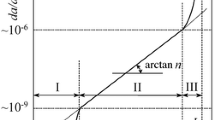Abstract
The well-known fatigue crack growth (FCG) curves are two-parameter dependents. The range of the stress intensity factor ΔK and the load ratio R are the parameters normally used for describing these curves. For engineering purposes, the mathematical representation of these curves should be integrated between the initial and final crack sizes in order to obtain the safety factors for stresses and life. First of all, it is necessary to reduce the dependence of the FCG curves to only one parameter. ΔK is almost always selected and, in these conditions, considered as the crack driving force. Using experimental data from literature, the present paper shows how to perform multiple regression analyses using the traditional Walker approach and the more recent unified approach. The correlations so obtained are graphically analyzed in three dimensions. Numerical examples of crack growth analysis for cracks growing under nominal stresses of constant amplitude in smooth and notched geometries are performed, assuming an identical material component as that of the available experimental data. The resulting curves of crack size versus number of cycles (a vs. N) are then compared. The two models give approximately the same (a vs. N) curves in both geometries. Differences between the behaviors of the (a vs. N) curves in smooth and notched geometries are highlighted, and the reasons for these particular behaviors are discussed.
Similar content being viewed by others
References
De Castro J T P, Landim R V, Leite J C C, et al. Prediction of notch sensitivity effects in fatigue and in environmentally assisted cracking. Fatigue & Fracture of Engineering Materials & Structures, 2015, 38(2): 161–179
Janssen M M, Zuidema J, Wanhill R J H. Fracture Mechanics. 2nd ed. Delft: VSSD, 2006
Lazzarin P, Tovo R. A notch intensity factor approach to the stress analysis of welds. Fatigue & Fracture of Engineering Materials & Structures, 1998, 21(9): 1089–1103
Atzori B, Lazzarin G, Meneghetti G. Fatigue strength assessment of welded joints: From the integration of Paris’ law to a synthesis based on the notch stress intensity factors of the uncracked geometries. Engineering Fracture Mechanics, 2008, 75(3–4): 364–378
Witek L. Crack propagation analysis of mechanically damaged compressor blades subjected to high cycle fatigue. Engineering Failure Analysis, 2011, 18(4): 1223–1232
Luke M, Varfolomeev I, Lutkepohl K, et al. Fatigue crack growth in railway axles: Assessment concept and validation tests. Engineering Fracture Mechanics, 2011, 78(5): 714–730
Walker K. The effect of stress ratio during crack propagation and fatigue for 2024-T3 and 7075-T6 aluminum. In: Rosenfeld M, ed. Effects of Environment and Complex Load History on Fatigue Life, ASTM STP 462. 1970, 1–14
Sadananda K, Vasudevan A K. Short crack growth and internal stresses. International Journal of Fatigue, 1997, 19(93): 99–108
Sadananda K, Vasudevan A K. Analysis of small crack growth behavior using unified approach. In: Ravichandran K S, Murakami Y, Ritchie R, eds. Small fatigue cracks: Mechanics, Mechanisms and Applications. Elsevier, 1998
Dinda S, Kujawski D. Correlation and prediction of fatigue crack growth for different R-ratios using K max and ΔK + parameters. Engineering Fracture Mechanics, 2004, 71(12): 1779–1790
Sadananda K, Vasudevan A K. Fatigue crack growth mechanisms in steels. International Journal of Fatigue, 2003, 25(9–11): 899–914
Sadananda K, Vasudevan A K. Crack tip driving forces and crack growth representation under fatigue. International Journal of Fatigue, 2004, 26(1): 39–47
Dowling N E. Mean stress effects in strain-life fatigue. Fatigue & Fracture of Engineering Materials & Structures, 2009, 32(12): 1004–1019
Miller M S, Gallagher J P. An analysis of several fatigue crack growth rate (FCGR) descriptions. In: Hudak S J, Bucci R J, eds. Fatigue Crack Growth Measurement and Data Analysis. ASTM, 1981, 205–251
Lipson C, Narendra J S. Statistical Design and Analysis of Engineering Experiments. New York: McGraw-Hill, 1973
Castro J T P, Meggiolaro M A. Fadiga: Técnicas e Práticas de Dimensionamento Estrutural sob Cargas Reais de Serviço, Create-Space, 2009 (in Portuguese)
Tada H, Paris P C, Irwin G R. The Stress Analysis of Cracks Handbook. 3nd ed. New York: ASME Press, 2000
Author information
Authors and Affiliations
Corresponding author
Rights and permissions
About this article
Cite this article
Duran, J.A.R., Boloy, R.M. & Leoni, R.R. Some remarks on the engineering application of the fatigue crack growth approach under nonzero mean loads. Front. Mech. Eng. 10, 255–262 (2015). https://doi.org/10.1007/s11465-015-0342-1
Received:
Accepted:
Published:
Issue Date:
DOI: https://doi.org/10.1007/s11465-015-0342-1




